TAGGED AS: Netflix, Sci-Fi, science fiction, television, TV
The season 1 success of German sci-fi series Dark hit fast and hard, with the title’s pages on Rotten Tomatoes jumping from outside of the top 100 in our most popular TV pages a week before its 2017 Netflix release to No. 1 the day of its launch on the streamer. Dark’s two subsequent seasons would also enjoy top traffic on their launch dates, with all three seasons popping into the top 5 for season 3’s launch in June 2020. All three seasons were also Certified Fresh, with season 2 boasting a perfect 100% Tomatometer score.
After that first season, the idea for new mind-bending Netflix show 1899 was percolating in the brains of series creators Jantje Friese and Baran bo Odar, and the married duo successfully pitched it to the streamer. The series became part of their overall deal, and development began after Dark’s third season.
But where Dark took advantage of scenic locations in Germany, 1899 employs technology developed by Jon Favreau and ILM for Disney+ series The Mandalorian to immerse its actors in lavish settings on a trans-Atlantic ship, in rural Scotland, and in 1800s Hong Kong. The effect is striking.
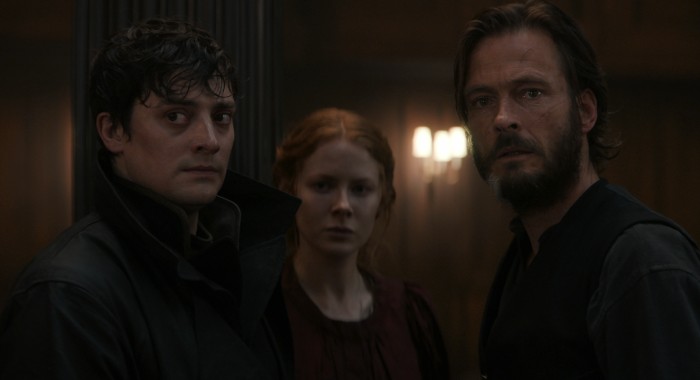
(Photo by Netflix)
Eight-episode 1899 stars a large ensemble cast led by Emily Beecham (The Pursuit of Love), Aneurin Barnard (Dunkirk), and Andreas Pietschmann (Dark) with Anton Lesser (Game of Thrones) in a pivotal role. The series unfolds the mystery of an immigrant ship sailing from Europe to New York that encounters a long-missing boat on the open sea. The passengers’ hopes for a new life in a new land during a new century turn into a nightmare as they confront their own secrets and try to solve the riddle enveloping their ill-fated voyage.
Friese and Odar spoke to Rotten Tomatoes ahead of 1899’s premiere about Dark’s surprise success, the challenges of working with innovative technology, and the pleasure they’ve taken in screening the finished product. Friese also reminded us that Dark won a “Best Netflix Original Series” bracket we published back in 2020, defeating the likes of Black Mirror and David Fincher’s Mindhunter.
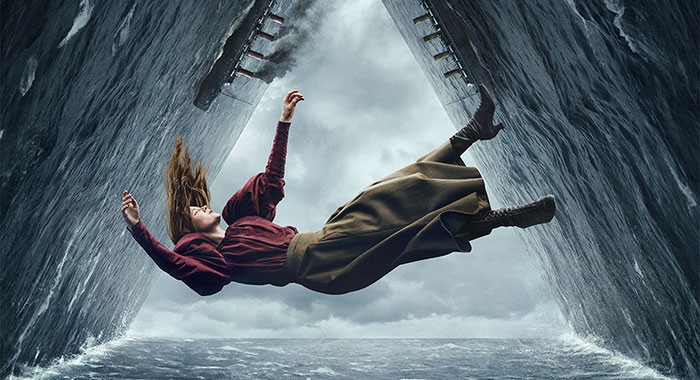
(Photo by Netflix)
Debbie Day for Rotten Tomatoes: A lot of Netflix shows seem to come out of nowhere – they aren’t screened for U.S. critics sometimes – and have great success. Dark was like that, shooting to the top of our “Most Popular TV” list. When the show started to have that level of success, what was that like for you?
Jantje Friese: It was actually really weird because I think there are so many people, especially in the industry, who are working, working, working, working to finally get to that moment of success. And obviously, on your way there, you’ve had things that didn’t work so well or you liked but for some reason no one watched them or I don’t know. So you’ve been through a constant process of frustration shaping you into the creator you become. And then suddenly success hits, and it feels way weirder than one can imagine. I think we were quite overwhelmed by it in the beginning.
The success was overwhelming, definitely. And I think actually quite a milestone in all of it was the Rotten Tomatoes poll, where for us it was just like, “OK, so we got through the first round, great. Second round, OK, we’re doing good. Third round, nah, no way we are going to keep going and going.” And it just went on and on. And then I think we won against Fincher’s Mindhunter, which was our favorite show at that moment, and we were like, “That’s impossible. It can’t be.” And then we just won. And it’s just, you try to understand but it’s just weird. It’s a weird feeling. Success is a weird feeling.
Baran bo Odar: Definitely. And you should not trust it because it has nothing to do with reality at the end. But it is nice that Dark at least is now part of pop culture, which we admire a lot. We really like pop culture. We really think there’s an art form in it and it’s interesting. And even Stephen King is, for us, pop culture, at least especially his very old stuff like It and stuff like that. So it’s nice to be even just a small part of it, but now that people are tattooing symbols from Dark on their arms, where I would say, “Please don’t do it.” But they’re doing it, or naming their children. There’s so many people that named their children after these characters. It’s weird but nice.
Friese: That was actually the weirdest thing: In the year of the second season, “Martha” and “Noah” were the most popular names in Germany, so it just felt crazy.

(Photo by Julia Terjung / Netflix)
That is a fun measure of success — I appreciate what that must have meant to you. You reminded me that we did that feature. Were you watching your Tomatometer score at the time? Dark (pictured above) was Certified Fresh for season 1, and then you went on to have three Certified Fresh seasons with really high scores.
Odar: No. In the first weeks, it was weird and it was overwhelming and it was literally – it was running over us and we were reading everything, following everyone, trying to, “Oh, maybe that’s a good idea.” And things like that. But then we understood that that’s for [the fans]. They go crazy, they vote for stuff, they do all these things, and Fresh Rotten Tomatoes is beautiful, but at the same time, it doesn’t do anything with our process, how we tell stories and what we want to tell. And we always fall into that thing where we are overwhelmed and then just quickly, that period gets shorter and shorter where we go back and say, “OK, let’s stop all this nonsense. Let’s go back to our roots. What do we want to tell for ourselves? What do we want to watch?” Because we started Dark like that.
It was a show for us. We thought no one will watch it, no one will be interested. But Netflix gave us the opportunity to do one season and fail. But at least we did what we wanted to do. Then it was the success, and we had to finish the whole thing in three seasons. We had the same approach with 1899 and, of course, there was a lot of pressure because of the success of Dark. And again, for a couple weeks, we were completely overwhelmed and felt like we were never going to do again something like Dark.
And we said, “Yes, of course, we will never do something like Dark because Dark is Dark.” We’re doing now another album. Let’s forget about everything. What do we want to do now next? We think the end result of 1899 is exactly this. We recently watched the show again with the cast last Friday as a last thing before the release. And it was so cool because we really liked the first season. We watched it in a row, it worked for us. We are happy, and now the world can take it and can do whatever it wants with it: hate it, love it, whatever. We will never know at the end — or we will know.
Friese: We will know.
Odar: We will know. But you should not care too much. It will still work.

(Photo by Netflix)
Were you still making Dark when you had the idea for 1899, or did you wait until you had put Dark aside to start working on a new project?
Friese: Actually, it goes years back. The really first initial idea was even before Dark, and then it became a bit more precise around after the first season of Dark, and then that’s when we pitched it to Netflix and they really liked it. So it became part of our overall deal, which included the second and the third season of Dark and the first season of 1899. So the cool thing was that we actually had those two seasons of Dark to think and process, but not really work hands-on on 1899. So there was this just gap of thinking probably between, and then it was clear that that was going to be the next project after Dark.
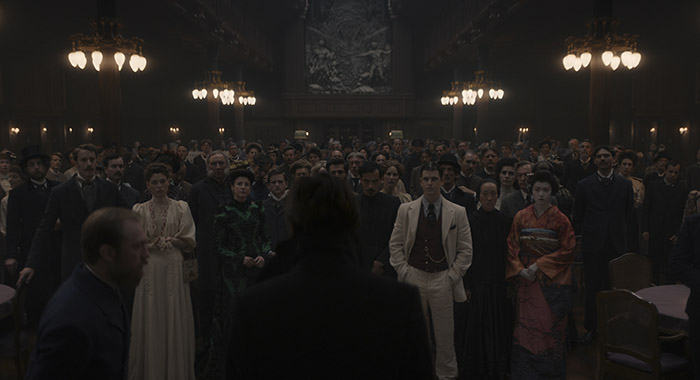
(Photo by Netflix)
Did the success of Dark give you more resources for 1899?
Odar: Definitely. And the most interesting part is not money at the end. It’s actors, to be honest. The casting process was — besides that it happened during the pandemic and we had to do Zoom castings, which really sucks. I cannot recommend that. But everyone knew Dark in every country, and it helped a lot to get sources that we usually don’t get maybe. So Lucy Bevan was the casting director and she did it from London and she could call any country and said, “The showrunners of Dark are like —” And they already said, “Whatever. Who do you need? Yes, we send you all the actors.” But that was actually awesome and helpful.
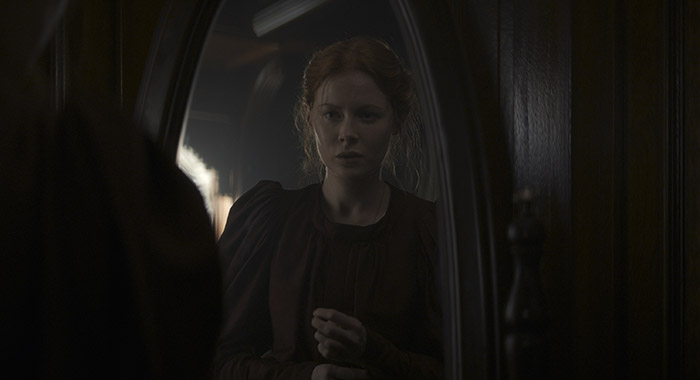
(Photo by Netflix)
You’ve got actors like Emily Beecham, for instance, who seems to have a big international following from her work on Into the Badlands. What was it like to start working with actors who might be more known internationally?
Friese: I think the way that we approach everything with whomever we work with and that also goes for crew who might come from a completely different career path and have done way bigger stuff, we really try to connect to — it sounds really cheesy — to the human person in front of us and not so much about that person’s track record. We’re actually not so interested in track records. It’s really finding the perfect fit for the roles, so it can be someone who hasn’t done anything or it can be someone who’s done a lot, but it’s really then finding out whether we connect, whether we have the same language and ideas around the material. And so it’s a way more, I think, intimate approach in finding out whether the work relationship works.
Odar: We’re always very honest and fair, which might be brutal because we really don’t care if you did big movies before or not. If you’re good for that role, perfect. If you’re not good for that role, we really don’t care if you’re the guy who did Top Gun or whatever … If it’s not a fit, you might last on this for three seasons, and it will be terrible for you, for us. Let’s not go for that role. Especially for a series, I think it has to be a perfect match.
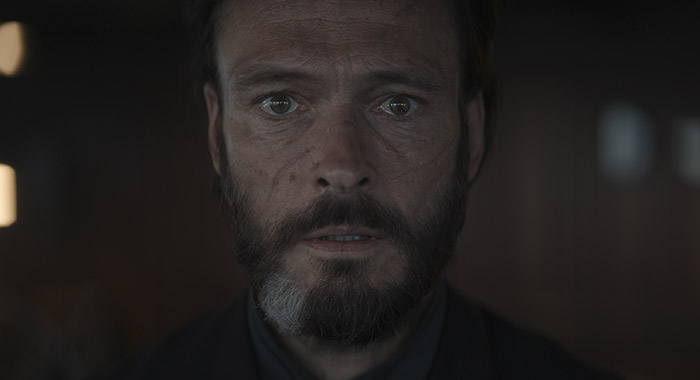
(Photo by Netflix)
For Andreas Pietschmann, who worked with you on Dark and is now working with you on 1899, obviously he didn’t have to audition for his role, did he?
Odar: Andy didn’t have to audition, but we auditioned a lot of people for that role because we started saying, “We won’t take anyone from Dark. We don’t want anyone from Dark.” So we [auditioned] a lot of German actors for that role.
Friese: And always kept going back to —
Odar: Kept going back to Andy.
Friese: Talking about Andy.
Odar: “And wouldn’t he be a fit?” “Yeah, but we said no one from Dark.” Then we start like, “Come on, rules are to break.”
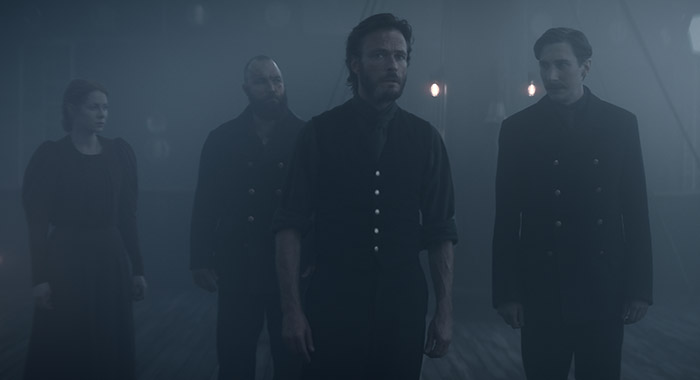
(Photo by Netflix)
I’ve watched six episodes of 1899 so far. It seems difficult to speak of the series without spoilers, so in your own words, what do you think people should expect of the series — how do you describe it?
Friese: It’s really, again, a mystery box, and as Bo said, you have to watch closely because things aren’t what they appear. But there’s also a promise: In episode 7 we are actually revealing everything — or not everything, but we are answering a whole lot of questions. So it’s not like you’re going to be in —
Odar: In the dark.
Friese: In the dark for a very long time. The way the whole season is constructed is kind of like a downward spiral where it goes — [Friese makes a whirlpool gesture and a spiraling whistle sound]. So it picks up pace throughout the season. It piles up questions, yes, but it also goes to answering them as well.
Odar: And then our approach is always treat the audience as a smart one and that people have fun to figure it out for themselves. Some will already figure out in ep. 1 because there are many clues in ep. 1, some in 2 and 3 and 4 and 5, and then in 7 they will get the big first answer. That doesn’t mean that there’s still a lot of other questions, but just I think a lot of people enjoy that and enjoyed that in Dark too, where like, “I knew it’s about that because I already figured it out in ep. 2.” And others will be like, “It took me till ep. 6, and I still didn’t get it.” But I hope they still have fun solving the puzzle and seeing this as a magic trick that they know it’s a trick but —
Friese: It’s also not Dark. I think that’s just very important, what Bo said, that we didn’t try to redo Dark. This is something completely different. It follows a different structure and is a mystery right on its own.
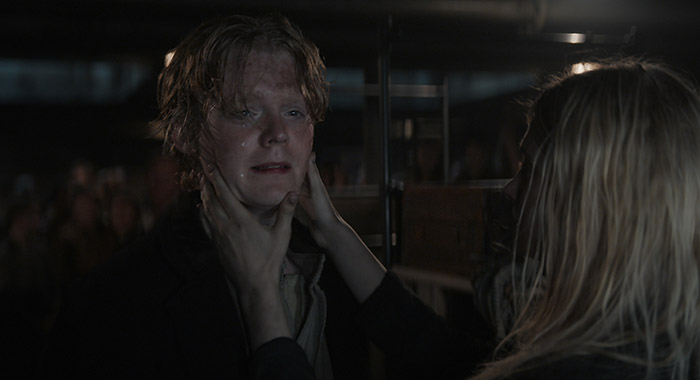
(Photo by Netflix)
What else should Dark fans not expect? What would you not want them thinking as they go into 1899?
Odar: It’s a very simple answer because a lot of people asked us, [including] fans: None of the characters from Dark will appear in 1899.
Friese: That’s not possible.
Odar: They’re not related.
Good to know.
Odar: Or, will they? Sorry, I know how to tease.
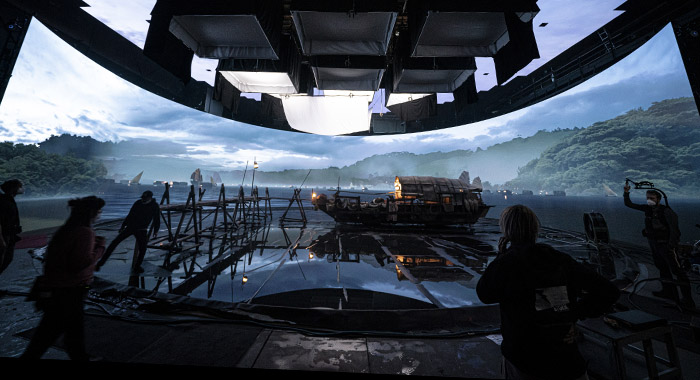
(Photo by Netflix)
I understand that you had a very unique filming experience in 1899. For people who are unfamiliar with the technology, working in a Volume facility, can you describe a little bit about what that’s like?
Friese: It’s basically the future version of your projection. So what you know from the ’50s when you have a couple sitting in a car, and you see the New York background bouncing up and down, and it doesn’t really match to the movement of the car? This is now the new thing where you still have something in the background which is like a huge gigantic TV screen, curved TV screen, or lots of screens put together. But it’s simpler to explain, it’s a TV screen and the content that is on there is not 2D; it’s actually 3D because it’s connected to the camera, so whenever the camera moves, the background moves at the same time. It’s basically the marriage between —
Odar: Video gaming.
Friese: Gaming and filming.
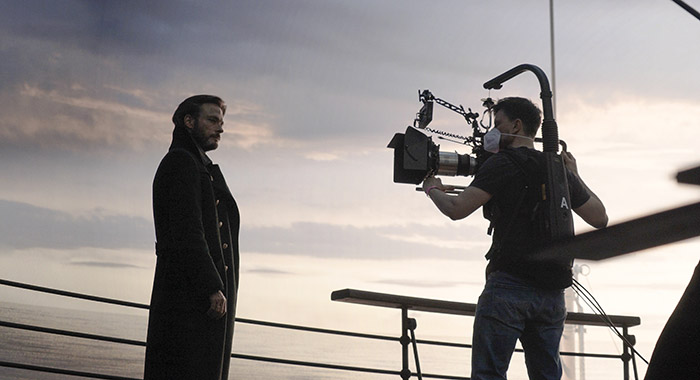
(Photo by Netflix)
It sounds like a challenge to learn how to use the new technology, of course, but maybe also a lot of fun with the opportunities that it opens up for you. Is that the case?
Odar: Definitely. But we prepped a year to learn the technology. It’s still at the beginning. We spoke to a lot of people from The Mandalorian, asked a lot of questions. They gave us really a lot of information. They were beautiful, nice people helping us with this too. [In] filmmaking, it’s like, “Don’t do this, don’t do this, and don’t do this because it didn’t work.”
And so we tried a lot of things to understand what it can do and what it cannot do. And that also means there’s a lot of frustration to it. But we love frustration because it means there’s a problem, and if there’s a problem, there’s always a solution, and it’s a very playful tool at the end because you start being a child again and trying to — [you think] How can we create that illusion that there is no reality, but we have to create a reality? And how can we play with foreground, mid-ground, and background, and what’s the perfect combination? How do we add atmosphere to it? What does it even mean, “atmosphere?” Is it just rain, or is it little particles that we also have to blow in with wind machines and things like that? It’s basically being a child again in the sandbox, creating whatever, a weird world, and then you get the garden hose and you put water on it and destroy the whole thing. So it’s a lot of fun, but it comes with a lot of challenge, and if you don’t embrace the challenges, it is very tricky. But if you do embrace them, it is actually very successful at the end. At least, that’s what we think. I think it looks pretty cool, but you have to understand how to use it wisely. You can’t just do anything. It’s not a magic tool where you just push a button and it immediately appears.
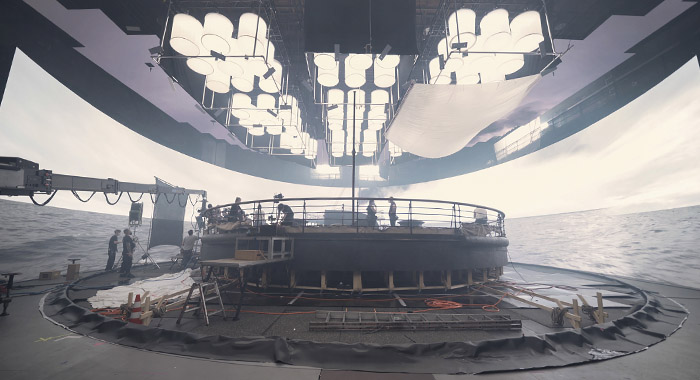
(Photo by Netflix)
It’s seamless from what I’ve seen so far. I wouldn’t know where it’s in use and where it’s not. I imagine some of the ocean scenes with the actors in the foreground maybe.
Friese: Yeah, everything that’s on deck is shot in the Volume then, but also the dining room, the engine room, all the landscapes, almost all the landscapes that you see.
Odar: Like Scotland.
Friese: Like Hong Kong is also Volume.
Odar: We shot almost 60 percent of that show in the Volume, so it is really a lot, but it’s exactly what we wanted to achieve. What you said, we didn’t want people to see that it’s there, because we only like visual effects if you don’t see them. Because otherwise it’s about visual effects, but it should be about the character and the story. So we are very proud especially about locations like the dining room, where you have interior sets that literally people went and came and visited us — even Greg Fraser who did Mandalorian as a DP — on set, and they saw the dining room and they couldn’t believe that they saw it for real on the screen and then on the monitors, and they were like, “How is this even possible?” The real location at least feels so real because you’ve seen landscape stuff before and you know the desert and mountains in the background; that’s easy to achieve. But actually the interesting things are more the interior stuff, and I think there’s the future. How can you create worlds and build things that used to be very expensive set builds?
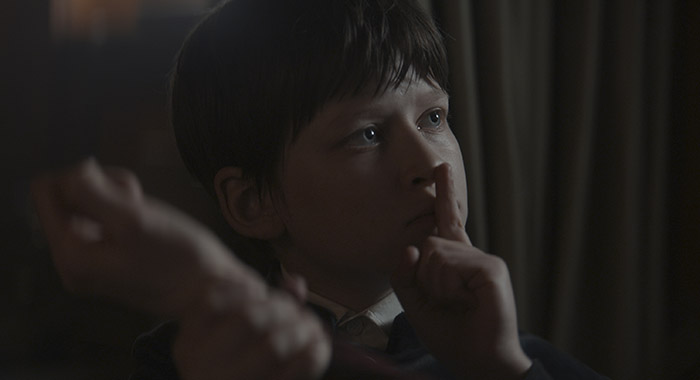
(Photo by Netflix)
Will 1899 have multiple seasons?
Friese: Yeah, it’s concepted again as a three-season mystery puzzle. So we’re sticking to that concept, because we truly believe that a mystery can only have three seasons, should never have more than three seasons, because in the first season you introduce what it is; in the second season, you have fun with what it is; and in the third season, you have to come to a very good conclusion.
![]() 78%
1899: Season 1
(2022)
launches on Friday, November 18 on Netflix.
78%
1899: Season 1
(2022)
launches on Friday, November 18 on Netflix.